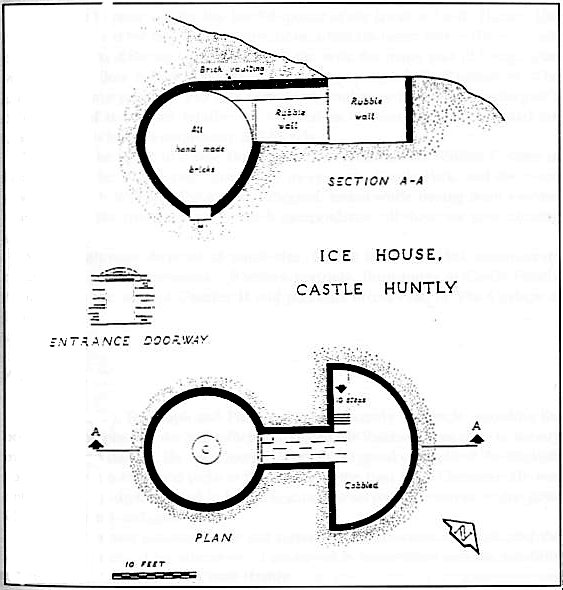The outer door had been
hung with crook and band hinges the remnants of the crooks remaining in
the wall. There had been a second door at the inner end of the passage as
is evinced by the remains of wooden bats in the walling to which wooden
standards would be fitted.
All the brickwork is in
perfect condition and the chamber after three hundred years is thoroughly
dry. In comparison from drawings and descriptions of other ice-houses
throughout Great Britain it would seem to be one of the finest examples
extant.
Owing to the heavy overload
of soil it was not possible to measure the thickness of the walling of the
passage or of the chamber itself or to find out whether it was constructed
with single or cavity walling as was found in some ice-houses of similar
design.
The whole structure of
Castle Huntly ice-house is very similar to that at Moredun House,
Midlothian, but the latter does not have the concave sides.
The ice-house at Castle
Huntly then called Castle Lyon was installed by Patrick Lyon 3rd Earl of
Kinghorne who succeeded to the Castles of Huntly and Glamis in 1646.
Records in the Charter Room at Glamis have been examined through the
kindness of Mr Kemp the Factor. Most of the payments entered in the
account books of the period in question are given only as total amount due
to the various tradesmen without details of the work done but in a ‘Compt
Book of the Lordship of Lyon for the year 1692’ there is recorded a
payment to one William Watson, Mason, for various jobs including ‘work
done at the Ice-House at Castle Lyon’ which shows that it was in
existence at that date.
After 1660 the Earl began
the reconditioning and improvement of Castle Huntly and lived there for
several years carrying out the work before he commenced any improvements
at Glamis and writing in his diary ‘The Glamis Book of Record’ about
Castle Huntly as a feudal fortalice says. "Such houses are worn
quite out of fashion, as feuds are which is a great happiness and I wish
that every man who has such houses would reform them for who can delight
to live in his house as in a prison and I am much addicted to general
reformation and have not a little propagate that humour in the country
where I live as general improvements have been more since the time of the
King’s happy restoration than has been a hundred years before."
The Earl was a good deal in
London at the Court of Charles II who in 1672 granted him a charter
erecting the lands of Castle Huntly into a Free Barony to be called the
‘Lordship of Lyon’ and in 1677 another charter provided that in future
the Earls of Kinghorne should be styled ‘Earls of Strathmore, Viscounts
Lyon and Barons Glamis, Tannadyce, Sidlaw and Strathdichtie’.
From about 1650 ice-houses
were being introduced into the mansions in St James Park in London ‘As
is the mode in France and Italy’. Accounts of building several in St
James Park area are to be found in Government Records.
In The Times of 19th
September 1957 there is a report of the discovery of an icehouse when a
bombed site in St James Place was being cleared up. This ice-house is
mentioned in a document of 1680 which implies that it was installed for
Barbara Villiers, Duchess of Cleveland as an adjunct to her mansion in
Cleveland Row. The ice-house was surveyed and photographed before the site
was again built on. From the photograph it appears to have been of similar
design to that at Castle Huntly.
The majority of the
seventeenth-century ices-houses were egg-shaped with domed tops and side
entrances. Such have been found scattered throughout the country; the
egg-shape with the earth pressure all round gave the greatest stability.
Later the design changed to cup-shaped chambers with vertical sides and by
the eighteenth and nineteenth centuries they became degenerated and often
were of rectangular shape and with mounts of earth raised over them. Few
eighteenth century country houses lacked this amenity and those properly
buried in a mound of earth often survived the mansion itself.
Local traditions of secret
underground passages are often traceable to a disused ice-house its
purpose being long forgotten. This tradition became attached to one at
Hereford Castle which was burrowed into the dry bank of a former moat. The
true nature of the passage was not realised until the Castle grounds came
into the possession of the Borough Council by whom it was cleared out and
preserved. The Hereford ice-house is situated at the end of a vaulted
passage and has a brick dome of excellent craftsmanship.
A similar tradition was
attached to the ice-house at Castle Huntly which has been in disuse for
over a hundred years and when the writer was making his survey of the
castle he was constantly being asked by the local people if he had found
any traces of the underground passage supposed to have run from Castle
Huntly to Glamis (a distance of 14 miles).
After 1728 Castle Lyon
ceased to be used as a residence by the Earls and was mostly occupied as a
Dower House by the widows of various Earls.

